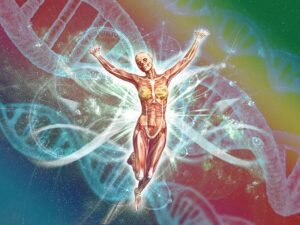- What is evolution?
- The process of gradual change in organisms over time.
- Who proposed the theory of evolution by natural selection?
- Charles Darwin.
- What is natural selection?
- The mechanism by which individuals with traits best suited to their environment tend to survive and reproduce.
- What is adaptation?
- A trait that helps an organism survive and reproduce in its environment.
- What is a species?
- A group of organisms capable of interbreeding and producing fertile offspring.
- What is speciation?
- The process by which new species arise from a single ancestral species.
- What is genetic variation?
- Differences in the genetic makeup of individuals within a population.
- What is genetic drift?
- Random changes in allele frequencies within a population due to chance events.
- What is gene flow?
- The transfer of alleles between populations through the movement of individuals.
- What is mutation?
- A change in the DNA sequence of an organism.
- What is reproductive isolation?
- The inability of different species to interbreed and produce fertile offspring.
- What is convergent evolution?
- The process by which unrelated organisms evolve similar traits due to similar environmental pressures.
- What is divergent evolution?
- The process by which closely related species evolve different traits due to different environmental pressures.
- What is coevolution?
- The process by which two or more species evolve in response to each other.
- What is artificial selection?
- The selective breeding of plants and animals by humans to produce desired traits.
- What is a fossil?
- The preserved remains or traces of ancient organisms.
- What is the fossil record?
- The collection of all known fossils and their placement in chronological order.
- What is radiometric dating?
- A method used to determine the age of rocks and fossils by measuring the decay of radioactive isotopes.
- What is the geological timescale?
- A system of chronological measurement used to describe the history of the Earth.
- What is the Cambrian explosion?
- A rapid diversification of animal life that occurred around 541 million years ago.
- What is punctuated equilibrium?
- The theory that evolution occurs in rapid bursts of change followed by long periods of stasis.
- What is the principle of superposition?
- The idea that in undisturbed layers of rock, the oldest rocks are at the bottom and the youngest are at the top.
- What is biogeography?
- The study of the distribution of species and ecosystems in geographic space and through geological time.
- What is the founder effect?
- A type of genetic drift that occurs when a small group of individuals establishes a new population.
- What is adaptive radiation?
- The rapid diversification of a single ancestral lineage into many species filling different ecological niches.
- What is homology?
- Similarity in structure or genetic sequence due to common ancestry.
- What is vestigial structure?
- An anatomical feature that has lost its original function in the course of evolution.
- What is the molecular clock?
- The idea that the rate of genetic mutation is relatively constant over time and can be used to estimate the timing of evolutionary events.
- What is Lamarckism?
- The discredited theory of evolution that suggests that organisms can acquire traits during their lifetime and pass them on to their offspring.
- What is allopatric speciation?
- Speciation that occurs when a population is geographically isolated from others of its species.
- What is sympatric speciation?
- Speciation that occurs without geographic isolation, often due to ecological or behavioral factors.
- What is sexual selection?
- Natural selection based on the ability to obtain mates and reproductive success.
- What is molecular biology?
- The study of biological molecules, such as DNA and proteins, and their role in the structure, function, and evolution of cells and organisms.
- What is a transitional fossil?
- A fossil that displays traits of both ancestral and descendant groups.
- What is mimicry?
- The resemblance of one species to another species or object for camouflage or deception.
- What is the bottleneck effect?
- A type of genetic drift that occurs when a population is greatly reduced in size, leading to a loss of genetic diversity.
- What is adaptive radiation?
- The process by which a single ancestral species evolves into a wide variety of different species to fill different ecological niches.
- What is gene flow?
- The movement of alleles from one population to another due to the migration of individuals.
- What is sexual dimorphism?
- Differences in physical characteristics between males and females of the same species.
- What is allopatric speciation?
- The formation of new species due to geographic isolation.
- What is sympatric speciation?
- The formation of new species within the same geographic area.
- What is gene pool?
- The total genetic information available in a population.
- What is homologous structure?
- Structures that are similar in different species because of common ancestry.
- What is analogous structure?
- Structures that have similar functions in different species but evolved independently.
- What is convergent evolution?
- The process by which unrelated organisms evolve similar traits due to similar environmental pressures.
- What is divergent evolution?
- The process by which closely related species evolve different traits due to different environmental pressures.
- What is the founder effect?
- The reduced genetic diversity that results when a population is descended from a small number of colonizing ancestors.
- What is genetic drift?
- The random fluctuation of allele frequencies in a population over time.
- What is stabilizing selection?
- Natural selection that favors the intermediate phenotype and selects against extreme variations.
- What is directional selection?
- Natural selection that favors one extreme phenotype over the other, causing the allele frequency to shift in one direction.



